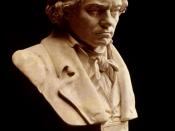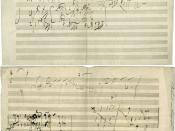A Formal Analysis on Beethoven's Piano Concerto No.3 in C minor , Op. 37
a)The "Beethoven Concerto"s and Op. 37's Placement in the Genre and as a continuation of Mozart's Style
b)Reception of the concerto-specifics of the concerto in a broad view
c)Formal and musical analysis with respect to the Concerto Form in the Classical Style (As a precursor of Romantic Age)
d)Conclusions
a)Beethoven Concertos
According to commonly agreed placement of this concerto among others, the way
that it still carries features of a classical concerto-but with a few innovations that look forward and that will be influential, this concerto is a "middle period" Beethoven work. This is also somehow supported by the fact that it lies in the middle of the other two that precede and postlude this one. The composer is still in his "modeling" phase, where he is hearing and thinking about how to modify, and bearing in mind the vast innovations the concertos No.4
and 5 will bring, this concerto is rightly called as a middle period work.
As it will be discussed more extensively, the formal layout of the 3 movements, as well as the specific techniques used throughout (i.e. placement of figurations, arrivals- wrong keys but eventually right solutions/as false recaps) signify a Mozart model in Beethoven's mind, with a few exciting additional ideas on top of the expectations. It is even more exciting to see that Beethoven will follow this pursuit by thwarting and changing the set rules and regulations nurtured by those expectations (e.g. the resolution of the cadenza).
b)Reception-Historical Details and a musical overview
According to Leon Plantiga's detailed account on the origins of the concerto, this
piece had been long planned in Beethoven's head, as a potential piece to portray his pianistic features. It was Beethoven's custom to play new...



Good!
well written.liked the fact that you included footnotes and bibliography
3 out of 3 people found this comment useful.